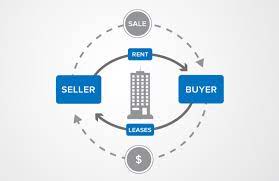Author: Allen Buchanan This post originally appeared on Location Advice and is republished with permission. Find out how to blog with us on theBrokerList.
 |
| Image Attribution:www.seekingalpha.com |
You’ve opted to own the location from which your company operates. A great move by the way! A Limited Liability Company was formed and owns the building. Presumably, the LLC’s members are similar to that of the occupying group.
You struck an agreement with the resident – your enterprise – to pay you (the LLC) an amount of money each month for the use of the address. In effect, you’re paying yourself. It’s a beautiful thing! Tax benefits are afforded the ownership LLC – depreciation of the asset, write-offs for any mortgage interest, property taxes, and operating expenses. Over time, the LLC’s investment appreciates.
Your occupying business pays rent just as it would to a landlord who has no stake in the company. Plus, because the owner of the real estate and operation are synonymous – if business ebbs and flows – so can the rent you pay yourself monthly. We are fortunate to have such a situation. We own the building from which we ply our brokerage. Each month Lee & Associates Orange – occupant – pays Taft Lee, LLC – owner – a dollar amount that provides a nice return on our investment. However, during the term of our ownership – we have deferred rent increases, banked reserves for a new roof, and kept the rent commensurate with market conditions. We can do this because we are the landlord AND the tenant.
Generally, a business or ownership transition will create a commercial real estate decision. As an example, if you acquire a competitor – will the real estate you own and occupy adequately house the marriage? Conversely, if you sell the business – your “tenant” – does the buyer of the business have their own location? Thus making yours excess? An election to move your enterprise out of state requires some time to facilitate and the equity in the real estate to buy your new location. In all cases – as you can surmise – you’ll make a decision. Keep the building or sell it.
When selling is chosen, one of the strategies employed is a sale-leaseback. By definition – a sale-leaseback inserts an investor – the sale – to replace the LLC ownership. The group – your company – stays in the building – the leaseback – and pays rent to the investor.
With that as a backdrop, let’s discuss what the title previews – two things that derail most sale-leasebacks.
The operating company cannot afford a market rent. Remember. One of the reasons you own your business location is to provide flexibility during tough times. Maybe the amount you allow your operation to pay is well below what comparable rents are. This is done because your two interests – business and building – are satisfied. In order to maximize the value of your investment, however – you’ll need to shore that delta. Someone buying your real estate – and relying on rent – is only concerned with a return on their money. Therefore, the price an investor will pay you is based upon a formula – known as a capitalization rate or cap rate. A cap rate is determined by net income (rent less expenses) divided by purchase price. The relationship is inverse – lower cap rate, higher price. But, the higher the rent – the higher the price…within reason. If the group housed cannot afford a market rent – the sum an investor will pay will result in a lower value. As a seller, you’d like to max your sale proceeds – but don’t want to saddle the business with an unsustainable monthly rent. Dilemma!
What to do with the proceeds? Your ownership LLC with a related company paying you is a tidy investment. If you sell the real estate, where can you reproduce the return? Recall, you’ll need to accomplish a tax-deferred exchange into another income property or be faced with a whopping tax bill. In the three transitions above – acquire a competitor, sell the business, or move out of state – a sale-leaseback could ensue. However, each presents complexity. Buying a competitor is easy – especially if you need more space. No lease-back needed. You simply sell the smaller and exchange into a larger. Boom. A business sale – especially if the business buyer doesn’t need your real estate – is challenging. You’ll have to fill a vacancy by selling or leasing. The timing of an out of state move works great for a sale-leaseback. Simply, point A is sold. Lease is created for two years. Point B is bought and rented short term while you prepare to move your enterprise. Lease expires on Point A and the relocation to Point B completed.
More on these later.
Allen C. Buchanan, SIOR, is a principal with Lee & Associates Commercial Real Estate Services in Orange. He can be reached at [email protected] or 714.564.7104. His website is allencbuchanan.blogspot.com.



